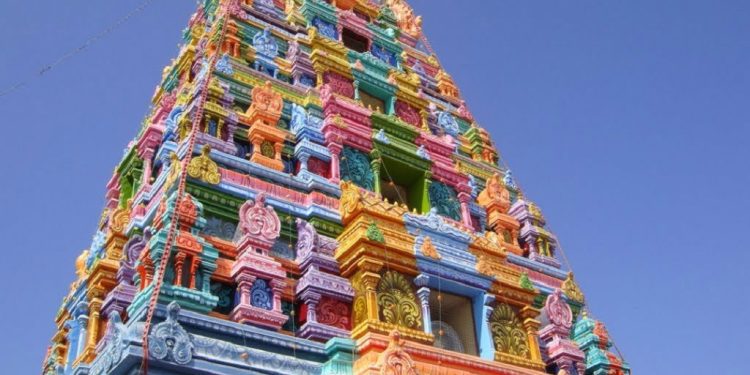Jogulamba Devi temple at Alampur, one of the 18 Sakti peethams in Indian sub-continent, including Shankari Devi temple in Sri Lanka, has been reconstructed after 615 years. According to historical sources, the temple was razed to the ground during Muslim invasion in 1390 AD.
Shrine’s History
Alampur was under the rule of Shatavahana Ishvakus of Nagarjunakonda, Badami Chalukyas, Rashtrakutas, Kalyani Chalukyas, Kakatiyas, Vijayanagara Empire and Qutb Shahis of Golconda. Alampur was previously Known as Halampuram, Hamalapuram And Alampuram. Name of this place as Hatampura mentioned in the inscription dated AD 1101 belongs to Western Chalukya, Tribhuvanamalla Vikramaditya VI. There are Navabhrama Temples, these impressive temples should be visited on tour to Andhra Pradesh not only because they are historically important but also because they reflect remarkable architectural skills.

Architectural Relevance of This Shrine
Jogulamba can be understood as “Gruha Chandi” (protector of our homes). As we noticed, the idol shows that the goddess has a lizard, scorpion, bat and human skull in her hair. These are the indications of evil and signs of deterioration of a house. Lizard is the primary indication that a house starting to lose its life. Gradually, the number of lizards shall increase which result in the welcoming of scorpions which is even worse. The next level would be the entrance of bats which may result in a death of humans living in that house. People believe that Jogulamba protects them and their shelters from all kinds of evils.
She is also worshipped to be freed from Vastu Doshas (faults in constructions). The temple attracts a large number of pilgrims from various parts for the country and major festivals like Dussera, Maha Shivaratri are celebrated with pomp. Alampur is the meeting point of the sacred rivers Tungabhadra and Krishna and is referred to as Dakshina Kashi(also known as Navabrahmeshwara Theertha) and the Western Gateway of Srisailam, the famous Shaivite (Shaivism) pilgrim centre. The principal deities at Alampur are Brahmeshwara and Jogulamba. It is surrounded by the Nallamalai hills. Alampur is situated on the left bank of the Tungabhadra river.
Shrine’s Map Location and How to Go There
By Road
NH7 is the nearest highway passing close to this village and you can easily get down at Alampur Cross Roads and hire a taxi/auto or bus to reach the temple, which is located roughly at a distance of around 15 km. APSRTC run frequent buses from Kurnool to Alampur Temple village. The nearest railway station is present at Jogulamba Hal, but not many trains halt here.
By Rail
Alampur has a railway station, which is nearly 8 km far from the town and is situated on the main line of Hyderabad – Kurnool. Also, a small halt station called “BBS Jogulamba Halt” is situated near Alampur station, and only a few trains connecting Hyderabad and Kurnool halt at these stations. The nearest major railway station is at Kurnool which is at just 27 km from Alampur and all major trains halt here. Alternatively, driving down or hiring a taxi would be an ideal option to reach the place easily.
By Air
Rajiv Gandhi International Airport Hyderabad [202 km]
Shrine Timings
Morning: 07:00 AM to 01:00 PM Afternoon: 02:00 PM to 08:30 PM
Events Celebrated at This Shrine
Major festivals like Dussera, Maha Shivaratri are celebrated with pomp.
Extra Information About this Shrine
There are very little accommodation facilities available at Alampur Jogulamba temple. R&B Guest House present at the location is normally given to VIPs, if these houses are vacant, then only they are allotted to the normal tourists on rent basis. Pilgrims can stay at Kurnool, where many lodges are present offering good food and accommodation facility.













































